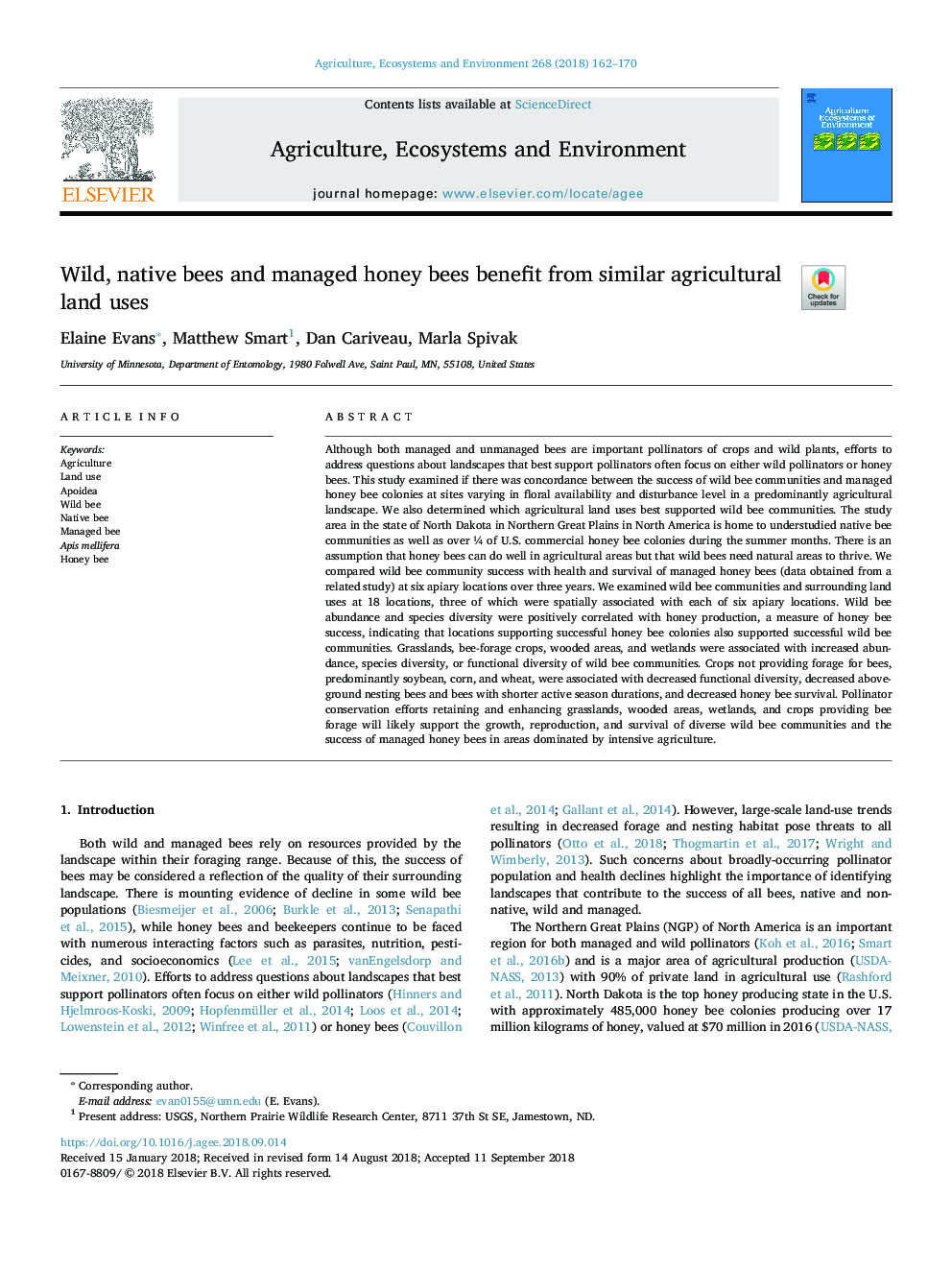| کد مقاله | کد نشریه | سال انتشار | مقاله انگلیسی | نسخه تمام متن |
|---|---|---|---|---|
| 11029299 | 1646556 | 2018 | 9 صفحه PDF | دانلود رایگان |
عنوان انگلیسی مقاله ISI
Wild, native bees and managed honey bees benefit from similar agricultural land uses
ترجمه فارسی عنوان
زنبورها وحشی، زنبور عسل و زنبور عسل مورد استفاده از مزایای مشابه زمین های کشاورزی بهره مند می شوند
دانلود مقاله + سفارش ترجمه
دانلود مقاله ISI انگلیسی
رایگان برای ایرانیان
کلمات کلیدی
ترجمه چکیده
هرچند زنبورهای اداره شده و مدیریت نشده، گردهافزارهای مهم محصولات کشاورزی و گیاهان وحشی هستند، تلاش برای پاسخ دادن به سوالات در مورد مناظر که بهترین استفاده را از گرده گرها دارند، اغلب به گرده افشان های وحشی و زنبور عسل توجه می کنند. این مطالعه مورد بررسی قرار گرفت که آیا بین موفقیت جوامع زنبور عسل و مستعمرات زنبور عسل زنبور عسل در سایت های مختلف در دسترس بودن گیاه و سطح اختلال در چشم انداز غالب کشاورزی مطابقت دارد. ما همچنین تعیین می کنیم که کدام زمین کشاورزی بهترین استفاده از جوامع زنبور عسل را پشتیبانی می کند. منطقه تحقیقاتی در ایالت داکوتای شمالی در دشتهای شمالی شمالی در شمال امریکا محل سکونتگاههای زنبور عسلهای بومی است و بیش از یک چهارم کلونیهای زنبور عسل زنبور عسل در ایالات متحده در طول ماه های تابستان. فرض بر این است که زنبور عسل می تواند در مناطق کشاورزی خوب عمل کند، اما زنبورهای وحشی به مناطق طبیعی نیاز دارند تا رشد کنند. ما مقایسه موفقیت و موفقیت زنبور عسل را با سلامت و بقاء زنبورهای زنبور عسل کنترل شده (داده های حاصل از مطالعه مرتبط) در شش مکان حوضچه در طی سه سال مقایسه کردیم. ما جوامع زنبور عسل و مناطق اطراف زمین را در 18 محل مورد بررسی قرار دادیم، سه مورد از آنها به صورت فضایی با هر یک از 6 مکان حومه قرار گرفته است. فراوانی زنبورهای وحشی و تنوع گونه ای با تولید عسل، اندازه گیری موفقیت زنبور عسل رابطه مثبت دارد، که نشان می دهد مکان هایی که از مستعمرات زنبور عسل زنبور عسل نیز حمایت می کنند، از جوامع زنبور عسل محسوب می شوند. علف های هرز، علوفه علوفه ای، مناطق جنگلی و تالاب ها با افزایش فراوانی، تنوع گونه ای و یا تنوع عملکردی جوامع زنبور عسل همراه بود. محصولاتی که علوفه ای برای زنبورها، بیشتر از سویا، ذرت و گندم فراهم نمی کنند، با کاهش تنوع عملکردی، کاهش زنبورهای تسلیحاتی در سطح زمین و کاهش طول دوره فعال در زنبورها و کاهش میزان زنده ماندن زنبور عسل همراه بود. تلاش های حفاظت کننده گرده افشان دهنده در حفظ و تقویت علف های هرز، مناطق جنگلی، تالاب ها و محصولاتی که از علوفه زنبور عسل استفاده می کنند، به احتمال زیاد از رشد، تولید مثل و بقا جوامع زنبور عسل وحشی و موفقیت زنبورهای زنبور عسل در مناطقی که تحت تأثیر کشاورزی شدید هستند، حمایت می شود.
موضوعات مرتبط
علوم زیستی و بیوفناوری
علوم کشاورزی و بیولوژیک
علوم زراعت و اصلاح نباتات
چکیده انگلیسی
Although both managed and unmanaged bees are important pollinators of crops and wild plants, efforts to address questions about landscapes that best support pollinators often focus on either wild pollinators or honey bees. This study examined if there was concordance between the success of wild bee communities and managed honey bee colonies at sites varying in floral availability and disturbance level in a predominantly agricultural landscape. We also determined which agricultural land uses best supported wild bee communities. The study area in the state of North Dakota in Northern Great Plains in North America is home to understudied native bee communities as well as over ¼ of U.S. commercial honey bee colonies during the summer months. There is an assumption that honey bees can do well in agricultural areas but that wild bees need natural areas to thrive. We compared wild bee community success with health and survival of managed honey bees (data obtained from a related study) at six apiary locations over three years. We examined wild bee communities and surrounding land uses at 18 locations, three of which were spatially associated with each of six apiary locations. Wild bee abundance and species diversity were positively correlated with honey production, a measure of honey bee success, indicating that locations supporting successful honey bee colonies also supported successful wild bee communities. Grasslands, bee-forage crops, wooded areas, and wetlands were associated with increased abundance, species diversity, or functional diversity of wild bee communities. Crops not providing forage for bees, predominantly soybean, corn, and wheat, were associated with decreased functional diversity, decreased above-ground nesting bees and bees with shorter active season durations, and decreased honey bee survival. Pollinator conservation efforts retaining and enhancing grasslands, wooded areas, wetlands, and crops providing bee forage will likely support the growth, reproduction, and survival of diverse wild bee communities and the success of managed honey bees in areas dominated by intensive agriculture.
ناشر
Database: Elsevier - ScienceDirect (ساینس دایرکت)
Journal: Agriculture, Ecosystems & Environment - Volume 268, 1 December 2018, Pages 162-170
Journal: Agriculture, Ecosystems & Environment - Volume 268, 1 December 2018, Pages 162-170
نویسندگان
Elaine Evans, Matthew Smart, Dan Cariveau, Marla Spivak,
